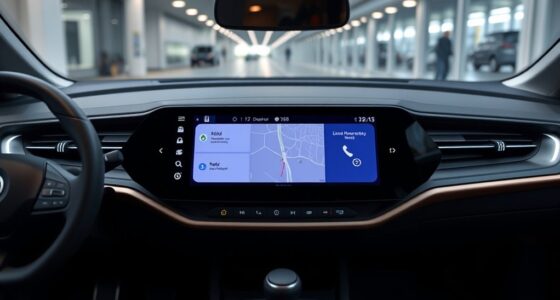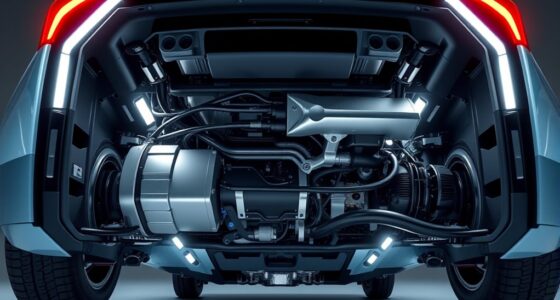Battery swapping mechanisms have evolved to offer rapid, around-one-minute exchanges that markedly cut down vehicle downtime. Standardized batteries make these swaps compatible across different models, boosting convenience and scalability. Advances in technology guarantee smoother, faster, more efficient swaps, helping to overcome charging limitations. Infrastructure development along major routes supports seamless exchanges. As this system becomes more widespread, you’ll discover how these innovations are shaping the future of electric mobility—there’s much to explore beyond the basics.
Key Takeaways
- Rapid battery swapping enables exchanges in about one minute, significantly reducing vehicle downtime.
- Standardized battery designs facilitate quick swaps across different vehicle models and brands.
- Infrastructure placement along major routes and urban centers supports widespread, efficient swapping networks.
- Collaboration among automakers, energy providers, and regulators is essential for developing compatible swapping systems.
- Future trends include increased station deployment, faster exchanges, and smarter systems for battery health management.

Have you ever wondered how electric vehicle owners quickly recharge their cars without waiting hours? The answer lies in innovative battery swapping mechanisms that are transforming the way we think about electric mobility. Instead of plugging in your car to charge for an extended period, you can simply swap out your depleted battery for a fully charged one in about a minute. This approach is gaining traction because it addresses two major challenges: battery technology limitations and the need for robust infrastructure development.
Battery technology is constantly evolving, but current batteries still take significant time to charge fully. Swapping stations bypass this obstacle by providing pre-charged batteries ready for immediate use. This system relies on standardized battery designs, making it easier for manufacturers to produce interchangeable units. As a result, you don’t need to worry about compatibility issues, and the infrastructure development around swapping stations becomes more straightforward and scalable. These stations are being strategically placed along major routes and urban centers, creating a network that supports quick and convenient exchanges.
Standardized batteries enable quick swaps, making infrastructure scalable and enhancing electric vehicle convenience.
The development of this infrastructure is critical. Building a network of battery swapping stations requires collaboration between automakers, energy providers, and government agencies. When infrastructure is well-developed, you benefit from increased convenience and reduced downtime. You simply drive into the station, swap your empty battery for a fully charged one, and continue your journey, much like refueling a traditional gasoline vehicle. This system also alleviates concerns over long charging times and range anxiety, making electric vehicles more practical for everyday use.
Furthermore, infrastructure development around swapping stations encourages the standardization of batteries across different vehicle models. This standardization means that you won’t have to worry about purchasing a new battery every time you switch vehicles. Instead, you’ll have access to a network of compatible batteries that can be swapped seamlessly, creating a more flexible and user-friendly experience. As technology advances, battery swapping stations are expected to become more widespread, with faster, more efficient exchanges and smarter systems that monitor battery health and availability. Additionally, standardization efforts are essential for ensuring compatibility across various brands and models, facilitating broader adoption of the system.
Frequently Asked Questions
How Do Battery Swapping Stations Ensure Battery Quality and Safety?
You can trust battery swapping stations to guarantee quality and safety by following strict safety protocols and verifying battery certification. They regularly inspect and test batteries before swapping, ensuring they meet safety standards. Advanced monitoring systems track battery health, preventing defective units from being used. This combination of certification, rigorous safety procedures, and continuous monitoring guarantees that each swapped battery is safe, reliable, and ready for use.
What Are the Cost Implications for Consumers Using Swapping Services?
Imagine you’re stepping into the future, where swapping your EV battery is quick and easy. You’ll find that these services boost cost efficiency and make electric driving more affordable. While some stations charge a fee per swap, the overall cost stays lower than traditional charging, saving you money over time. Plus, the convenience means you spend less on maintenance and energy, making EV ownership more accessible and budget-friendly.
How Does Battery Swapping Impact Vehicle Design and Manufacturing?
Battery swapping influences vehicle design and manufacturing by requiring you to focus on seamless battery pack integration and flexible vehicle architecture. You’ll need to create standardized battery modules and adaptable chassis designs, which can increase initial development costs but streamline production. This approach allows for quicker maintenance, reduces downtime, and can lower long-term costs for consumers, while impacting how manufacturers plan and assemble EVs around interchangeable battery systems.
Are There Any Environmental Concerns Associated With Battery Swapping?
Sure, swapping batteries sounds like a dream—until you realize it might turn your parking lot into a hazardous waste dump. You could be creating more battery recycling challenges and environmental hazards, with leftover hazardous waste piling up faster than your charging times. While quick swaps seem convenient, they risk increasing toxic waste, polluting waterways, and complicating disposal. So, think twice before celebrating the end of long charging waits.
What Advancements Are Expected in Battery Swapping Technology in the Next Decade?
You’ll see advancements like smart grid integration, making battery swapping more efficient and responsive to energy demands. Modular battery packs will become more common, allowing quicker upgrades and repairs. These innovations will reduce downtime, improve scalability, and promote sustainability. Expect the next decade to bring seamless, standardized swapping systems that integrate with renewable energy sources, making electric vehicle charging faster, greener, and more convenient for users like you.
Conclusion
Think of battery swapping as a well-choreographed dance, where each step moves seamlessly into the next. From quick, one-minute swaps to standardized systems, you’re orchestrating a future where energy flows effortlessly, like a river meeting the ocean. Embracing these mechanisms means you’re guiding your journey toward a world where charging downtime becomes a thing of the past, and mobility is as smooth as a perfectly executed dance. The future’s rhythm is already set—are you ready to join in?









